Frustration becomes natural when users struggle to determine how your new product works. This highlights the critical role of creating user documentation in today’s product landscape.
Effective user documentation bridges your product and its users, guiding them through its functionalities, troubleshooting common issues, and empowering them to unlock their full potential.
Whether you’re building documentation for software, a physical product, or a service, this blog will help you learn how to create user documentation that empowers your users. We’ll discuss its types, benefits, and examples and explore the best user documentation tools.
What Is User Documentation?
User documentation refers to written materials or resources that provide guidance and instructions to product or service users. It helps users understand and use software or technology-related product documentation or services effectively.
User documentation can take various forms, such as manuals, guides, tutorials, FAQs, online help systems, and training materials.
These documents may cover installation and setup instructions, user interface navigation, feature explanations, troubleshooting tips, and best practices.
For example, user documentation for a mobile application would explain how to download and install the app, navigate through different screens and menus, perform specific tasks, and customize settings. It could also include video tutorials to demonstrate complex procedures visually and an FAQ section addressing common user inquiries.
How to Create End User Documentation: Step-by-Step Guide
Creating user documentation helps ensure that your product or service is accessible, understandable, and easy to use for your target audience. Here are key steps to create better user documentation:
1. Learn About Your Customers & Their Problems
Who is on the receiving end of this process? What problems are they facing, and how can your documentation solve them? All these questions should be answered right in the first step.
A deep dive into your target audience will help you understand the content you should add to your documentation and make informed decisions about the tone, voice, and terminology.
Another way to do your research right is through competitor analysis. Look at your competitor’s documentation, take a leaf out of its strategy, and incorporate all the effective elements in your own.
2. Build a Solid Plan & Strategy
After you have understood your customers, create a foolproof plan that defines the critical stages of your journey, the structure of the content, and every other crucial element of your documentation.
The plan should make a few things crystal clear to your team:
- The goal of your user documentation
- Structure & format of the document
- Publishing format
- Roles & responsibilities of your team
- Due date of the project
You can always tweak the strategy to incorporate changes as your project progresses.
3. Build a Strong Team for Collaborative Authoring
Next, you should encourage team collaboration between subject matter experts, product developers, project managers, and other stakeholders who can offer their rich insights and expertise.
Give your team a unified platform to share their knowledge and work collectively towards building meaningful articles.
While collaboration is a great strategy to get faster results, it can also create misalignment and confusion if each team member’s role and responsibilities are not well-defined.
4. Set Up a Content Structure That Looks Logical
Before creating content, establish a simple structure with key categories and subcategories. A well-organized user documentation helps customers easily find what they need without confusion.
This structure organizes information logically, making it easier to search and navigate. Most documentation tools offer templates with pre-built structures, allowing you to focus on content creation.
Enhance the experience with a home page, table of contents, and internal linking for smoother navigation and faster information discovery.
5. Start Writing
With the structure ready, your team can begin adding relevant content. Keep articles concise and easy to navigate for a great user experience.
Follow these tips:
- Write short, clear paragraphs
- Avoid jargon
- Define technical terms where they appear
- Break down complex information into manageable sections.
- This ensures documentation is user-friendly and easy to understand.
6. Review & Publish Your Documentation
Customers quickly form brand perceptions. Provide them with a seamless experience, and they’ll remember you. Offer faulty content, and their trust in your documentation and brand will diminish.
To avoid this, establish a multi-step review process for every article. Authors can use predefined statuses like Draft, In Progress, Ready for Review, and Published to track content progress.
This ensures transparency and clarifies which articles are reviewed. You can even create custom statuses for editing help. Only set the status to ‘Published’ after thorough reviews, ensuring error-free content goes live.
7. Monitor & Improve Article Performance
It’s crucial to monitor the performance of your document to keep it relevant and aligned with evolving products and customer needs.
Top documentation tools offer built-in reporting systems that track key metrics like successful and failed searches, top and poor-performing articles, and broken links.
You can update content regularly by analyzing these metrics, ensuring its continued relevance. This helps you identify what works, improve weak areas, and create new or modify existing articles.
Why Businesses Should Create User Documentation?
Well-written user documentation is essential to the user experience, bridging complex technology and its users. Let’s look at the benefits of effective user documentation:
Enhances User Experience
Well-written user documentation enhances the user experience by making technology more accessible and easily understood.
It helps users navigate the learning curve of new software or devices, allowing them to use products more efficiently—especially important for complex products with multiple features.
Enables Self-Service Support
Users today prefer quick solutions, and detailed user documentation offers essential self-service support, enabling them to find answers independently without waiting for customer service.
This autonomy empowers users and reduces support queries, allowing customer service teams to focus on complex issues while saving time and resources.
Reduces Onboarding Time
Comprehensive user documentation can significantly reduce the time and resources spent onboarding new users or employees.
Users can self-learn at their own pace by providing clear, comprehensive guides and tutorials, minimizing the need for extensive training sessions. This accelerates the adoption process and helps users become more productive more quickly.
Increases Product Adoption & Customer Retention
Extensive user documentation can be a deciding factor in a product’s adoption. When potential users see that comprehensive help and resources are available, they are more likely to commit to using the product.
Also, creating documentation can help retain customers by reducing frustration and ensuring they can solve problems and discover new features independently, leading to higher satisfaction and loyalty.
Supports Global Reach
Simple yet comprehensive user documentation, especially in multiple languages, can significantly broaden a product’s appeal across geographical and linguistic markets.
It ensures that users worldwide have the necessary resources to use the product effectively, thus supporting global sales and adoption strategies.
Ensures Legal & Safety Compliance
Creating detailed user documentation is beneficial and a regulatory requirement for many products and services, especially in the tech, healthcare, and manufacturing industries.
Detailed documentation ensures that users are aware of any safety information, legal disclaimers, or compliance guidelines related to the product’s use, protecting both the user and the company from legal issues and ensuring safe use.
Enhances Brand Reputation
The quality of user documentation reflects on the brand itself. Detailed, clear, and user-friendly documentation signals customers that a company is professional, customer-oriented, and committed to providing value.
This can enhance the company’s reputation, promote a positive brand image, and encourage word-of-mouth recommendations.
What Are the Common Types of User Documentation?
Each type of user documentation has its own purpose and target audience. Organizations often combine these documentation types to cater to user preferences and needs. Here are the most common types:
User Manuals or Guides
These provide detailed instructions on how to use a product or service. They typically cover topics like installation, setup, configuration, and usage.
They are often organized in a step-by-step format and may include diagrams, screenshots, or illustrations to enhance understanding.
Quick Start Guides
These focus on helping users get started with a product or service quickly. They provide an overview of the most essential features and functions, enabling users to use the product without going through the entire user manual.
They are helpful for users who prefer a simplified and condensed version of the documentation.
Tutorials
These step-by-step guides explain how to perform specific tasks or achieve particular goals with a product or service. They often include screenshots, videos, or interactive elements to demonstrate the required actions.
They are helpful for users who want to learn by doing and prefer a hands-on approach to learning.
Online Help Systems – Knowledge Base or Help Center
These web-based or integrated help systems are accessible within a product or service. They provide context-sensitive information, relevant help, and guidance based on the user’s current location or task.
They offer a searchable knowledge base of articles, FAQs, troubleshooting steps, and other relevant resources to assist users in real-time. They enable self-service for end users so that they can figure out the product/service themselves without contacting support.
FAQs (Frequently Asked Questions)
FAQs compile a list of common questions that users may have and their respective answers. They are often organized by topic or category and can cover multiple user inquiries.
FAQs are helpful for users who prefer quick answers to specific questions without having to search through lengthy documentation.
Release Notes
Release notes provide information about the latest updates, bug fixes, and new features introduced in a product or service. These documents help inform users about any changes in functionality or enhancements in the latest version.
They help users stay updated and ensure they are aware of any changes that may impact their usage.
FREE. All Features. FOREVER!
Try our Forever FREE account with all premium features!
What Are the Best Practices for Creating User Documentation?
Creating user documentation that empowers your audience requires more than listing features and functionalities. Here are some best practices to keep in mind:
Employ a User-Centric Approach
Always consider the user’s perspective. Anticipate their needs, address their pain points, and strive to create an intuitive and enjoyable experience.
Maintain a Consistent Style & Tone
Establish a style guide for your documentation to ensure language, formatting, and tone consistency. This will create a cohesive and professional feel, making your documentation more accessible to read and understand.
Use a Content Management System (CMS)
Employ a CMS to manage your user documentation effectively. This allows for easy updates, version control, and collaboration among team members.
Include User Feedback
To continuously improve your documentation, actively solicit and incorporate user feedback. Provide feedback mechanisms within your documentation or conduct user surveys to gather insights.
Test & Validate Your Documentation
Before releasing your documentation, thoroughly test it with a representative group of users. This helps identify any gaps, inconsistencies, or areas of confusion.
Optimize for Findability
Ensure your documentation is easily discoverable through search engines and within your website or application. Use relevant keywords, meta descriptions, and clear titles to improve search engine optimization (SEO).
Promote Your Documentation
Actively promote user documentation through your website, social media, email newsletters, and in-app notifications.
Measure & Analyze
Track key metrics, such as page views, search queries, and user feedback, to measure your documentation’s effectiveness and identify areas for improvement.
Embrace Accessibility
Design your documentation with accessibility in mind, ensuring people with disabilities can use it. Use clear fonts, alt text for images, and proper heading structure.
Localize Your Content
Consider translating your documentation into multiple languages to cater to different regions and preferences if you have a global audience.
What Are Some Examples of User Documentation?
Let’s explore some examples of effective user documentation that sets the bar high for clarity, comprehensiveness, and user experience.
1. RMS
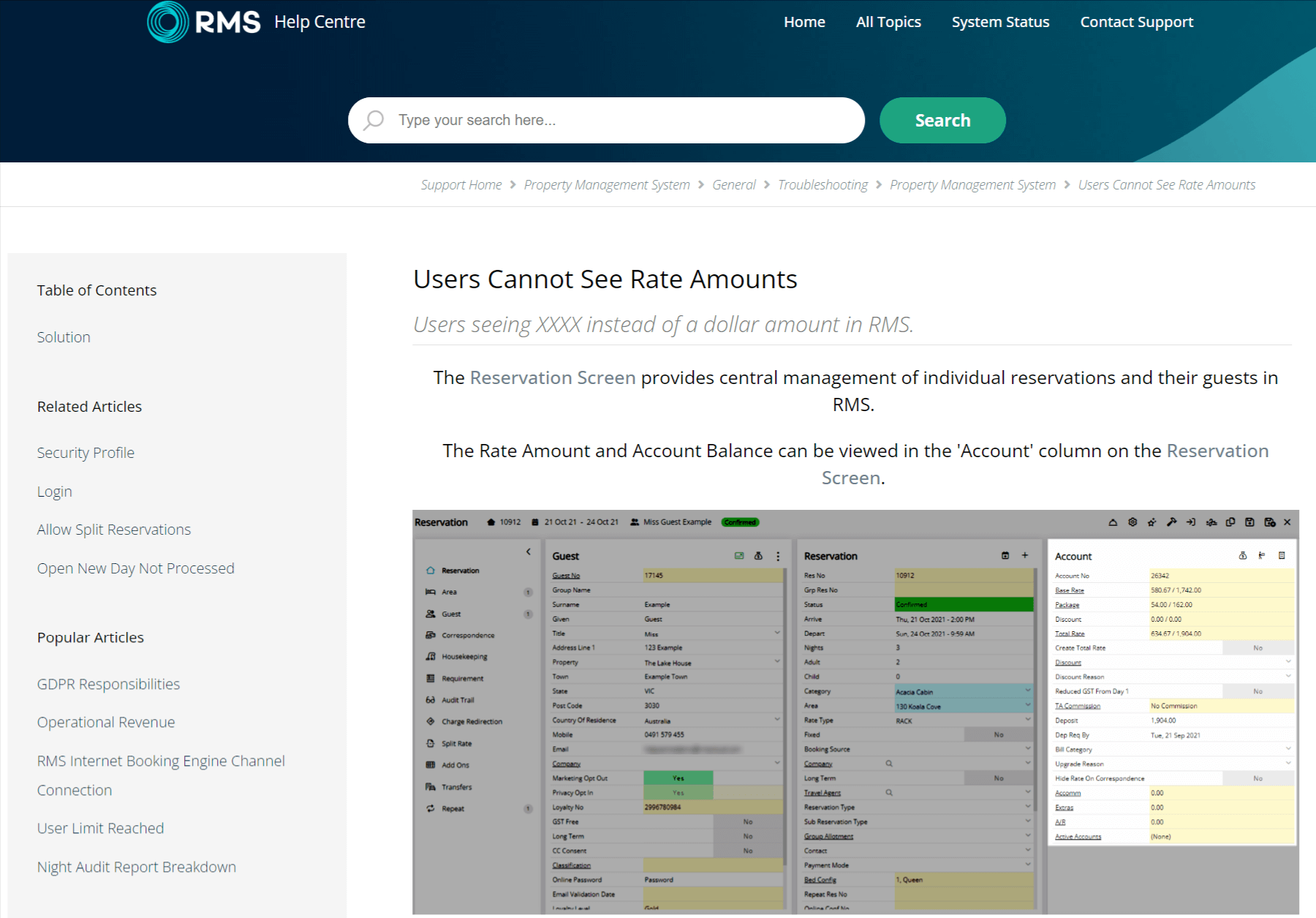
RMS Cloud’s documentation provides clear, step-by-step instructions for resolving issues related to viewing rate amounts. Its simple layout, supported by screenshots and easy-to-follow text, ensures that users can quickly grasp each step.
Visual aids such as highlighted icons and buttons enhance clarity while including a solution section and a detailed breakdown of actions fosters user engagement. The page structure is logical, with sections neatly divided for efficient troubleshooting.
2. Manage Engine by Zoho
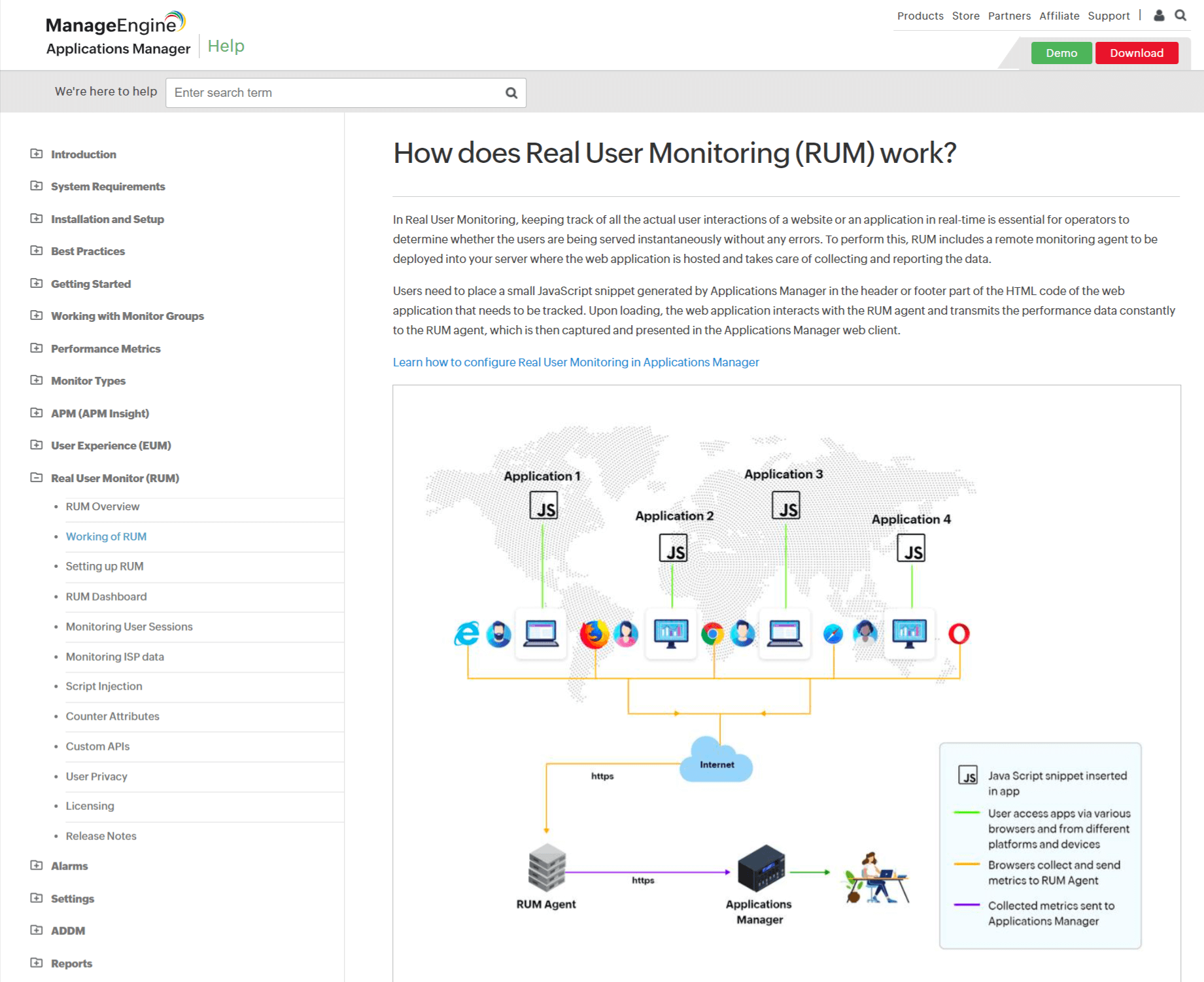
ManageEngine’s help page documentation clearly explains how Real User Monitoring (RUM) works, supported by technical descriptions.
It incorporates concise text and visual diagrams to explain the deployment of RUM agents and their integration with web applications. The page highlights critical performance metrics, such as page views, and includes valuable notes to guide users on agent limitations.
The layout is straightforward, ensuring that technical steps are easy to follow for users implementing RUM monitoring.
3. Riscure

Riscure’s help page explains how to set up a glitch amplifier, providing clear, step-by-step instructions for hardware configuration. It uses detailed diagrams and concise descriptions to guide users through the assembly process.
Visual aids like images enhance understanding, while the breakdown of components and the connections needed, helps streamline the setup. This structured approach ensures users can follow along efficiently when building a glitch amplifier for security testing or analysis.
Which Are the 5 Best Tools to Create User Documentation?
User documentation helps users understand and utilize a product or service effectively, leading to increased satisfaction, reduced support costs, and improved product adoption. Let’s explore the top 5 tools:
1. ProProfs Knowledge Base – Best for Easily Creating Help Sites, User Manuals & Private Knowledge Bases
ProProfs Knowledge Base has an AI-powered text editor with built-in prompts and quick actions to help users quickly create error-free help content. Features like version control and co-authoring facilitate collaboration and ensure accuracy, while the platform’s powerful search functionality empowers users to find the information they need quickly.
The platform also supports real-time collaboration with features like internal comments for collaborative editing, role-based workflows for outlining member responsibilities, and conditional content for secure information sharing.
What You Will Like:
- Variety of pre-approved templates to quickly create knowledge base articles
- Revision history to track up to 30 recent changes made to your knowledge base
- Rich integration with in-house tools: ProProfs Chat, ProProfs Help Desk, and ProProfs Survey, along with popular 3rd party apps
- Control the layout, format, and presentation of your knowledge base with the help of CSS
- Authenticate and protect identities with Enterprise SSO (Single Sign-On) using IDP services like Okta and Azure AD.
What You May Not Like:
- No downloadable or on-premise version
- Dark user interface option is not available
Pricing:
Forever Free Plan with all the premium features for small teams. Paid plan starts at $49/author/month.
2. Whatfix – Best for Creating Interactive Help Content
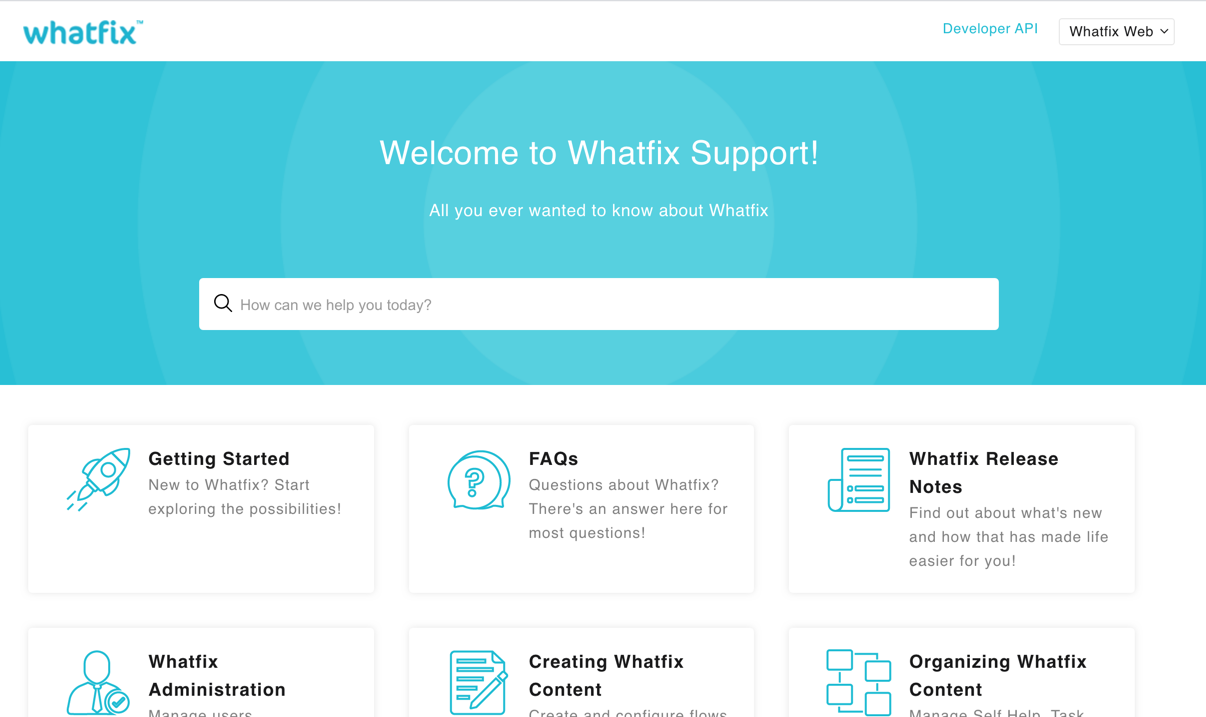
WhatFix goes beyond traditional user documentation by enabling an interactive, in-app guidance platform that helps users learn and adopt software applications more effectively. Instead of static manuals or help centers, it empowers users with contextual guidance directly within applications, guiding them through processes, explaining features, and offering support.
The platform empowers you to create various forms of interactive guidance, including walkthroughs, tutorials, and self-help resources. These can be tailored to specific user roles and needs, ensuring a personalized and efficient learning experience.
What You Will Like:
- Contextual support and real-time feedback
- Seamlessly integrates guidance within the application’s workflow
- The ability to easily export scenarios into PowerPoint and articles.
Pricing:
Forever Free Plan with all the premium features for small teams. Paid plan starts at $49/author/month.
3. Nuclino – Best for Fast Collaboration to Bring Knowledge, Docs, and Projects Together in One Place
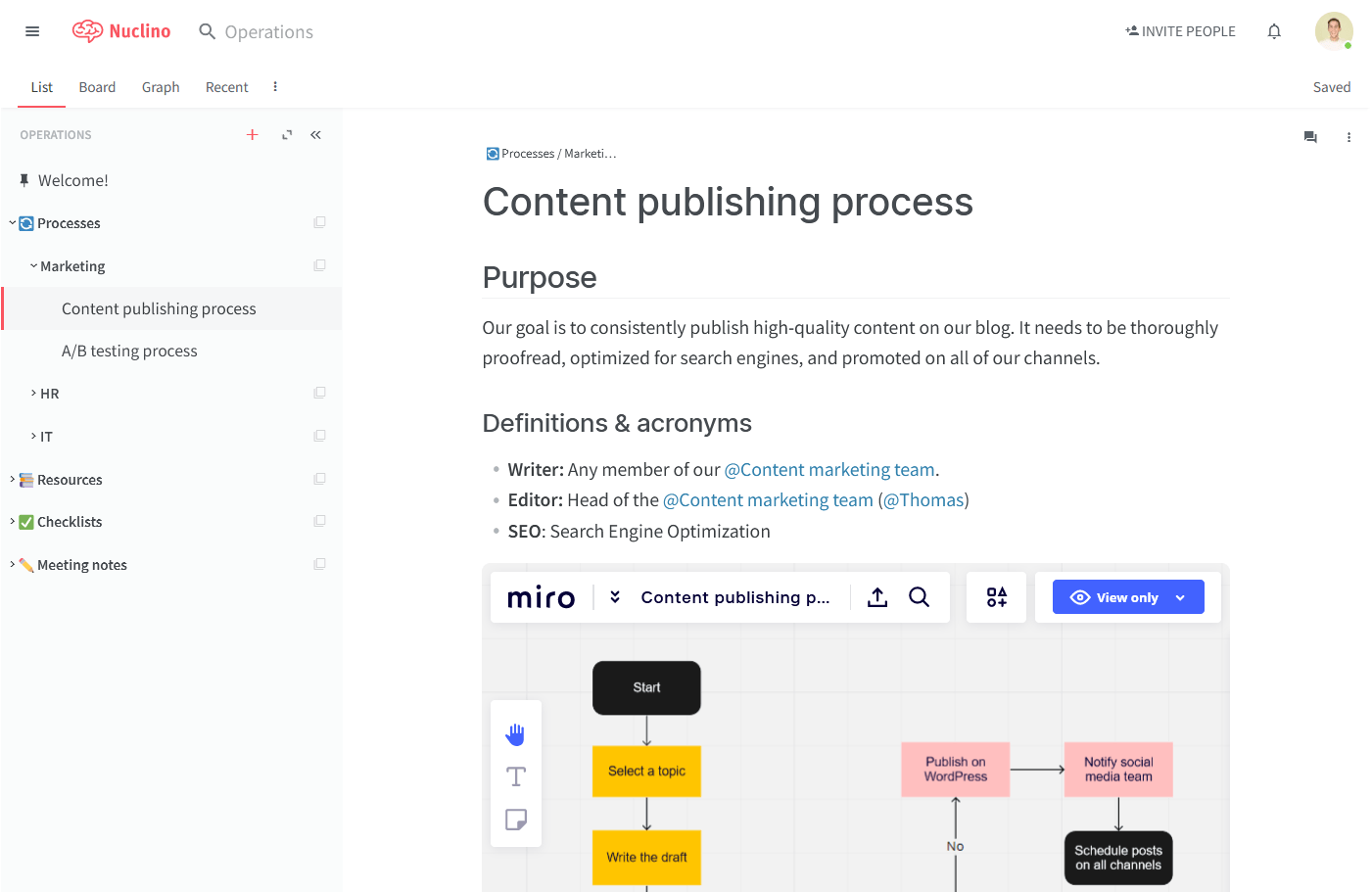
Nuclino‘s clean interface, combined with its intuitive editor and powerful linking capabilities, makes it a breeze to build comprehensive and user-friendly documentation. Its unique graph visualization allows you to link related documents, creating a web of interconnected knowledge that users can easily navigate and explore.
The platform’s real-time collaborative editor allows multiple users to work on the same document simultaneously, fostering teamwork and ensuring everyone is on the same page. It also supports various content formats, including text, images, videos, and embedded interactive elements, allowing you to create engaging and informative documentation.
What You Will Like:
- Powerful search functionality ensures that users can quickly find the information they need
- Intuitive interface and minimalist design minimize distractions
- Supports Markdown for text formatting, providing flexibility in documentation styling.
What You May Not Like:
- There’s no offline mode
- The customization options for the interface and workspace were too restricted.
Pricing:
A free plan is available. Paid plan starts at $6/user/month.
4. Document360 – Best for Creating Online Documentation
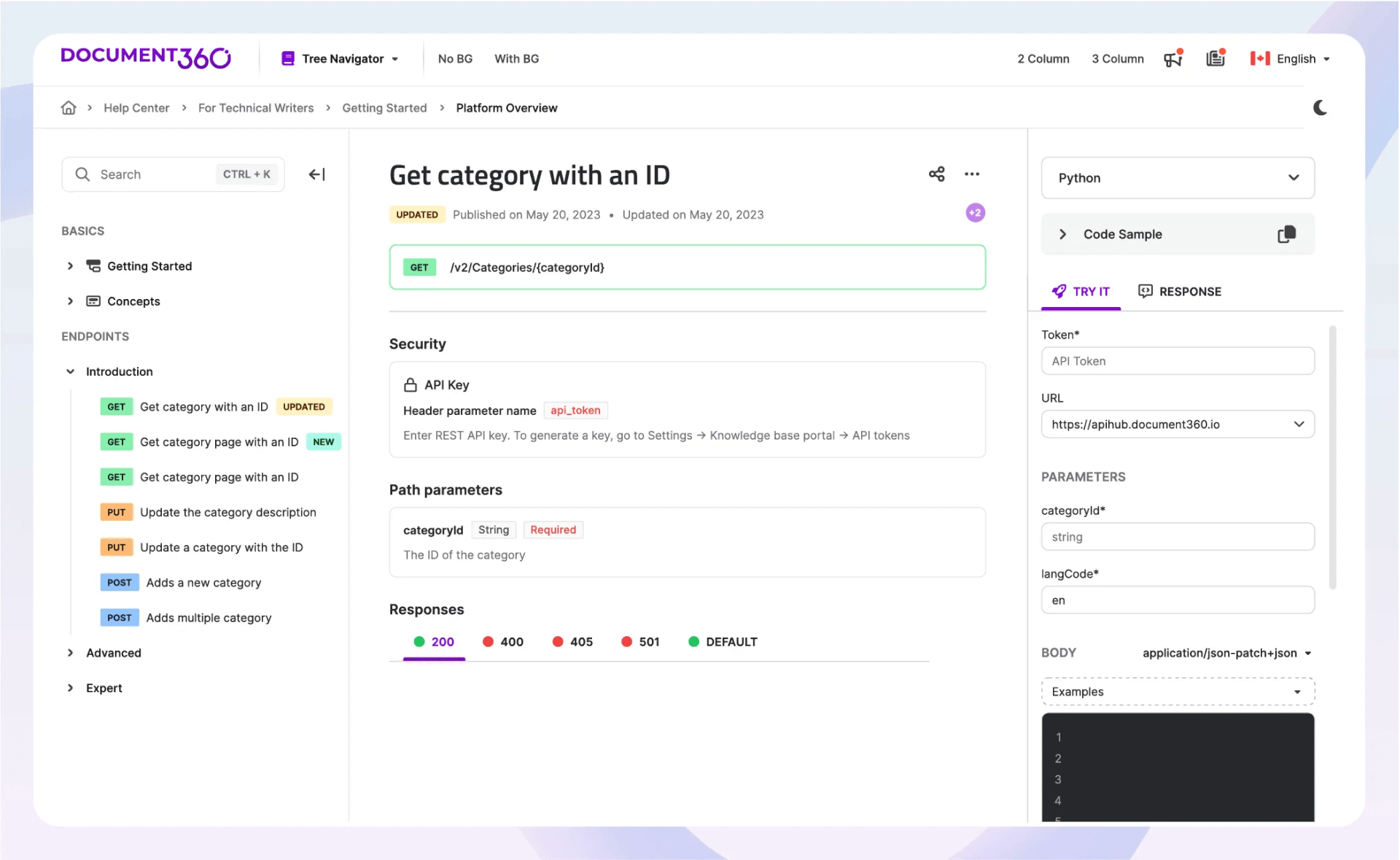
With Document360, you can create dynamic and engaging user manuals that are easy to navigate and search. Its intuitive editor, with customizable templates and various formatting options, lets you present information clearly and visually appealingly.
Document360 also simplifies the process of keeping your documentation up-to-date. Its real-time collaboration features allow multiple team members to work on the same document simultaneously, ensuring accuracy and consistency.
What You Will Like:
- Version control system, which tracks changes and allows you to revert to previous versions if necessary
- Built-in CMS that makes it easy to organize and manage documentation
- Enables managing user roles and access permissions to control who can view and edit content.
What You May Not Like:
- The customization options for styling and layout are limited
- I have noticed that sometimes, the search functionality shows inaccurate results.
Pricing:
A free plan is available. Paid plan starts at $199/project/month.
5. GitBook – Best for Creating Smart Technical Documentation
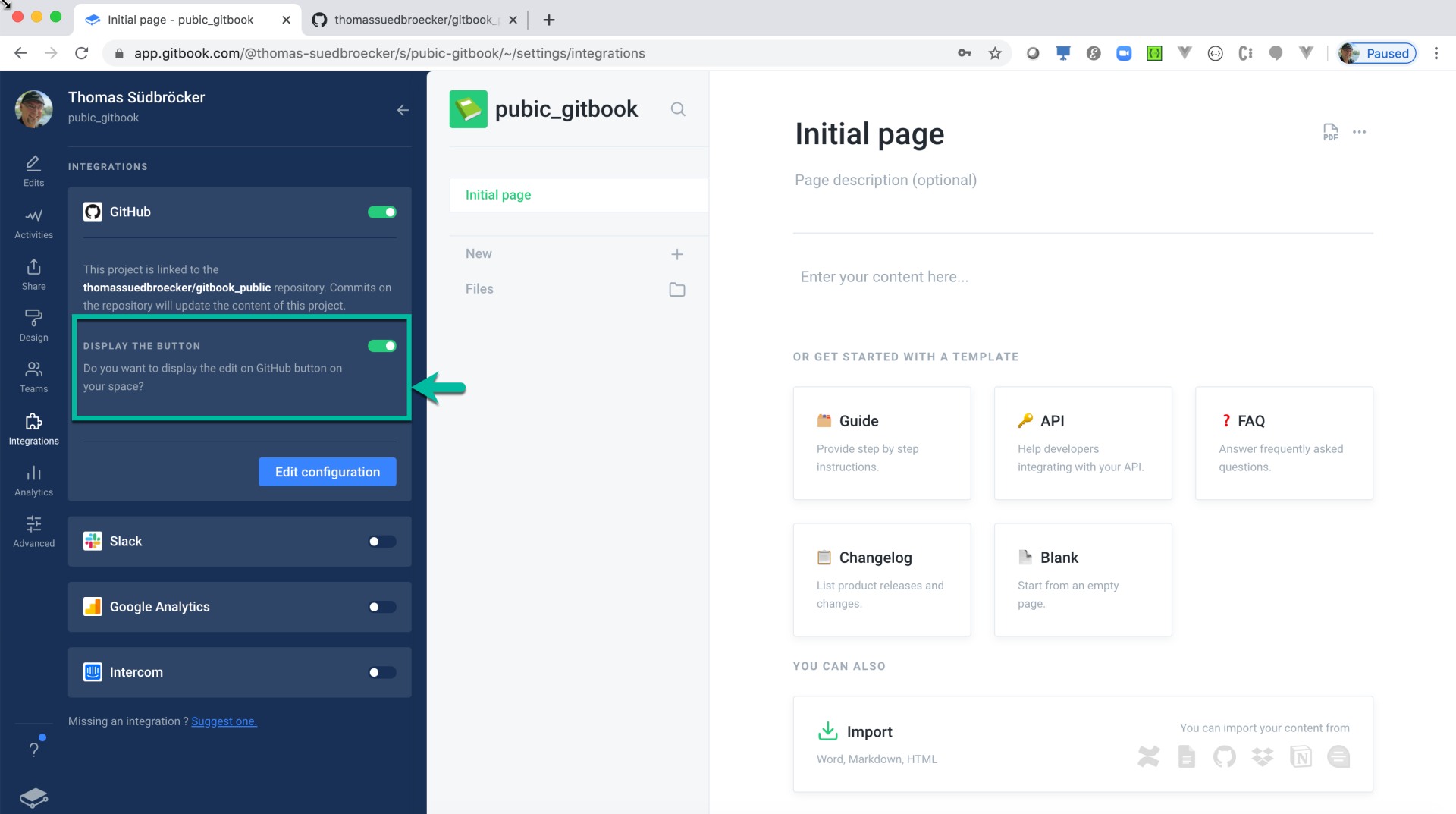
GitBook’s intuitive and collaborative editor allows multiple users to work on the same document simultaneously, enabling teamwork and ensuring everyone is on the same page. It supports various content formats, including Markdown and rich text, making creating well-structured and engaging documentation easy.
GitBook also simplifies the process of publishing and sharing your documentation. You can easily host your documentation on GitBook’s platform, creating a professional and user-friendly experience for your audience.
What You Will Like:
- Customizable themes and branding options to add your personal touches to the documentation
- Powerful search functionality ensures users can quickly find the information they need
- The version control system tracks changes and allows you to revert to previous versions if necessary.
What You May Not Like:
- I found the UI a bit complicated compared to its competitors
- Sometimes, it shows the message “Unexpected Error Occurred” when writing on a page with multiple images and media files
- Cannot resize drawings.
Pricing:
A free plan is available. Paid plan starts at $8/user/month.
Improve Product Adoption with Effective User Documentation
User documentation is vital to product success. It helps users make the most of your products, reduces support costs, and boosts customer satisfaction.
If you want to create detailed user documentation, ProProfs Knowledge Base can be an effective solution. Its intuitive interface, AI-powered search, customizable templates, and seamless integrations make it ideal for building a knowledge base that empowers your users and strengthens your brand. You may explore the tool more or request a demo below.
 Tips
Tips
We’d love to hear your tips & suggestions on this article!
FREE. All Features. FOREVER!
Try our Forever FREE account with all premium features!

 We'd love your feedback!
We'd love your feedback! Thanks for your feedback!
Thanks for your feedback!







